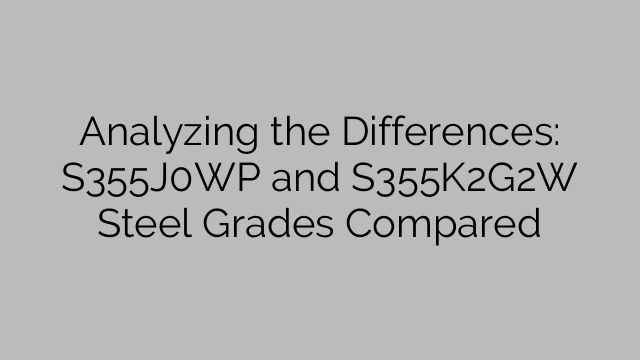Analyzing the Differences: S355J0WP and S355K2G2W Steel Grades Compared
Steel grades play a vital role in the construction and manufacturing industries. They determine the structural integrity, durability, and performance of steel products. Among the numerous steel grades available, S355J0WP and S355K2G2W are two popular choices. Both grades belong to the weathering steel category and are used primarily for outdoor structures. However, there are several key differences between these two steel grades that are worth exploring.
S355J0WP, also known as 1.8945, is a European standard steel grade that falls under the EN 10025-5 specification. It is classified as a structural steel with improved atmospheric corrosion resistance. The “J” in its designation indicates that it is impact tested at 0 degrees Celsius. This grade offers excellent weldability, machinability, and formability, making it suitable for a wide range of applications, from bridges and buildings to railway wagons and tanks.
On the other hand, S355K2G2W, also referred to as 1.8967, is a European standard steel grade regulated by EN 10155:2000. Similar to S355J0WP, it is classified as a structural steel with improved atmospheric corrosion resistance. However, S355K2G2W has a higher carbon content compared to S355J0WP, which enhances its mechanical properties. This grade is primarily used for welded, bolted, and riveted structures in various applications, such as bridges, buildings, and offshore structures.
One significant difference between these two steel grades lies in their chemical composition. S355J0WP contains elements such as copper, chromium, nickel, and phosphorus, which contribute to its enhanced corrosion resistance. S355K2G2W, on the other hand, has higher levels of carbon, manganese, and silicon, providing it with improved mechanical properties.
The mechanical properties of these steel grades also vary. S355J0WP has a minimum yield strength of 355MPa and a minimum tensile strength of 510-680MPa. Its elongation at break is around 20-22%, indicating its ability to withstand deformation without fracturing. S355K2G2W has a minimum yield strength of 355MPa and a minimum tensile strength of 470-630MPa. Its elongation at break is slightly lower, at around 18-20%. These differences in mechanical properties make each grade suitable for specific applications where strength or formability is prioritized.
Another important aspect to consider is the effect of weather conditions on these steel grades. Both S355J0WP and S355K2G2W are designed to develop a protective layer when exposed to atmospheric corrosion. This layer, known as a patina, acts as a barrier against further corrosion, preserving the structural integrity of the steel. However, the corrosion resistance of S355J0WP is higher than that of S355K2G2W due to its specific chemical composition.
In conclusion, while both S355J0WP and S355K2G2W belong to the weathering steel category and offer improved atmospheric corrosion resistance, they have significant differences. S355J0WP has a diverse range of applications, excellent weldability, and a higher corrosion resistance due to its specific chemical composition. S355K2G2W, on the other hand, has higher carbon content, providing it with improved mechanical properties. Understanding these differences is crucial for selecting the appropriate steel grade for specific projects, ensuring optimal performance and longevity.

